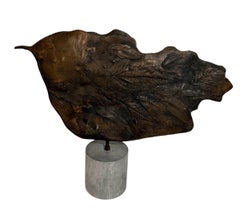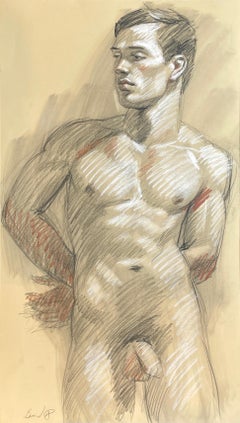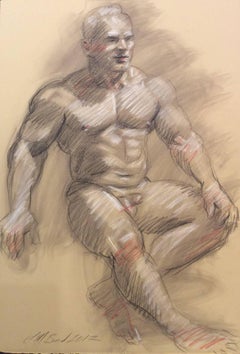Roberto Estopiñan Art
to
4
4
3
3
"Homenaje de Camilla Claudel 5, " Conte Crayon and Pencil on Alcantara, 1992
By Roberto Estopiñan
Located in Long Island City, NY
Artist: Roberto Estopiñan, Cuban (1921 - 2015)
Title: Homenaje de Camilla Claudel 5
Year: 1992
Medium: Conte Crayon and Pencil Drawing on Alcantara h...
Category
1990s Expressionist Roberto Estopiñan Art
Materials
Conté, Handmade Paper, Pencil
Large Latin American Modernist Bronze Abstract Cuban Master Roberto Estopinan
By Roberto Estopiñan
Located in Surfside, FL
Roberto Estopinan, Cuban, 1920 - 2015
Dimensions: 24.5" wide x 13" high plus 6" high base.
Roberto Estopiñán (1921–2015) was a Cuban American sculptor known for his sculptures of the human form, including political prisoners. Born in Camaguey, Cuba, he lived in the United States for over fifty years. His works are held by major institutions such as the Museum of Modern Art, the Whitney Museum and the Smithsonian Museum of American Art.
Roberto Gabriel Estopinan, a sculptor, draftsman, and printmaker, was born in Havana, Cuba on March 18, 1921. Estopiñán enrolled at the San Alejandro Academy when he was just 14 years old and became the protegé and studio assistant of the sculptor Juan José Sicre. After graduation he traveled first to Mexico, where he met and befriended Francisco Zuniga, and studied Pre-Columbian sculpture. In 1949 he traveled to Europe, visiting England, France and Italy. In these trips he encountered the sculpture of Henry Moore and Marino Marini, and their humanistic yet formal visions would be influential on Estopinan's work. Estopiñán was a pioneer of direct carvings using wood and of welding techniques in Latin America. Throughout the 1950s, Estopiñán received important prizes at various national exhibitions in Havana. In 1953 he was the only semi-finalist from Latin America at the Tate Gallery's international sculpture competition for a Monument to the Unknown Political Prisoner. In 1961, the artist moved to New York, where he resided until 2002.
Roberto Gabriel Estopiñán a Cuban emigre sculptor who emigrated to exile in the United States not long after Fidel Castro’s revolution in 1959, is considered one of Latin America’s most important 20th-century artists. His work, which includes drawings and prints as well as sculptures in wood and bronze, is in the collections of New York’s Museum of Modern Art, the Smithsonian’s American Art Museum, the Art Institute of Chicago, and the Detroit Institute of Art, among many locations. He is best known for his stark, disturbing renderings of political prisoners, the fruit of his own experiences as a dissident under both Castro and his predecessor, the dictator Fulgencio Batista, and for his representations of the female torso that can remind viewers of both classical statuary and the high-modern, abstractly elongated work of Henry Moore.mHe was born in Havana to a father from Asturias in northwest Spain and a mother of African descent. Estopiñán was something of a prodigy. At the age of fourteen, he won the first prize in drawing at the Centro Asturiano, a regional association for Cubans of Asturian descent. Shortly afterward he received special permission to enter the San Alejandro Academy of Fine Arts in Havana. At the school he was mentored first by its director, the painter Armando Menocal (1863-1941), then by the landscape artist Antonio Rodríguez Morey (1872-1967), and finally by Juan José Sicre (1898-1974), regarded as one of Cuba’s greatest sculptors. Sicre, a professor of sculpture at the Academy, had helped introduce European modernist art to Cuba, and from the 1930s through the 1950s had sculpted monumental figures in Havana of José Martí and other Cuban national heroes that stand to this day. Estopiñán was first Sicre’s student, then his assistant, and, finally, his colleague for the next fifty years. After graduating from San Alejandro in 1942, Estopiñán began simultaneously teaching art at the Ceiba del Agua School for young men, assisting Sicre in public art projects and developing his own artistic vision. He also traveled widely, to Mexico, New York, France, and Italy. From the late 1940s through the 1950s his sculpture evolved from an early neoclassical phase under the influence of Maillol to what he defined as “formalist humanism”: emphasizing the abstract beauty of the shapes he sculpted while not abandoning the human figure as the basis of his work. As the 1950s progressed he chose to carve in native Cuban woods...
Category
20th Century Abstract Roberto Estopiñan Art
Materials
Bronze
Homenaje de Camilla Claudel 2, Conte Crayon and Pencil on Alcantara
By Roberto Estopiñan
Located in Long Island City, NY
Artist: Roberto Estopiñan, Cuban (1921 - 2015)
Title: Homenaje de Camilla Claudel 2
Year: 1992
Medium: Conte Crayon and Pencil Drawing on Alcantara h...
Category
1990s Art Deco Roberto Estopiñan Art
Materials
Conté, Handmade Paper, Pencil
Homenaje de Camilla Claudel 1, Conte Crayon and Pencil on Alcantara, 1992
By Roberto Estopiñan
Located in Long Island City, NY
Artist: Roberto Estopiñan, Cuban (1921 - 2015)
Title: Homenaje de Camilla Claudel 1
Year: 1992
Medium: Conte Crayon and Pencil Drawing on Alcantara h...
Category
1990s Art Deco Roberto Estopiñan Art
Materials
Conté, Handmade Paper, Pencil
Related Items
MB 023 (Figurative Life Drawing of Handsome Male Nude by Mark Beard)
By Mark Beard
Located in Hudson, NY
Academic life drawing of male nude with charcoal and graphite by Mark Beard, "MB 023"
graphite, Conte crayon and charcoal on Arches paper
30.5 x 17.5 inches unframed
Signed, lower le...
Category
2010s Contemporary Roberto Estopiñan Art
Materials
Conté, Charcoal, Archival Paper, Graphite
$1,650
H 30.5 in W 17.5 in
MB 005 (Modern, Traditional Style Figurative Life Drawing of Muscular Male Nude)
By Mark Beard
Located in Hudson, NY
Figurative nude drawing on Arches paper
graphite, conte crayon and charcoal on Arches paper
22 x 15 inches unframed
Contemporary figurative life study drawing of a reclining male nu...
Category
2010s Modern Roberto Estopiñan Art
Materials
Conté, Graphite
Bronze Sculpture “Arise”
By Frank Arnold
Located in Fresno, CA
Frank Arnold is thought by many to be one of the foremost abstract figurative painters and sculptors of our time. He is a living master whose work is considered to be both personal a...
Category
2010s Abstract Roberto Estopiñan Art
Materials
Bronze
MB 702 (Contemporary Life Drawing of Male Nude by Mark Beard)
By Mark Beard
Located in Hudson, NY
MB 702 (Contemporary Life Drawing of Male Nude by Mark Beard)
graphite, Conte crayon and charcoal on Arches paper
30 x 19 inches unframed
Con...
Category
2010s Contemporary Roberto Estopiñan Art
Materials
Conté, Charcoal, Archival Paper, Graphite
Bronze Sculpture “Understander”
By Frank Arnold
Located in Fresno, CA
Frank Arnold is thought by many to be one of the foremost abstract figurative painters and sculptors of our time. He is a living master whose work is considered to be both personal a...
Category
2010s Abstract Roberto Estopiñan Art
Materials
Bronze
Untitled
Located in New York, NY
This drawing by James Childs is offered by CLAMP in New York City.
Category
21st Century and Contemporary Contemporary Roberto Estopiñan Art
Materials
Paper, Conté, Graphite
"Bird" Abstract Bronze Sculpture with Wooden Base
Located in Houston, TX
W. R. Stevenson's abstract bronze sculpture titled "Bird". The unique sculpture stands on a sleek wooden base and has a plaque that includes the artist and title.
Artist Biography: William Robert Stevenson was born in 20 May 1925 in Eugene, Oregon. His family moved to Minneapolis, MN but he promptly returned to Oregon and Washington during the Great Depression to work in the Works Progress Administration (WPA). Hoping to study Art, his future was sidetracked when he was drafted into the United States Army at age 17 years old in early 1942. Being a strong swimmer, and having worked at stables as a child, he initially served in the last US Cavalry Corps, and also as a Swimming Instructor for the United States Army. Upon the abolition of the Cavalry Corps, he was trained as a Gunnar and Tank Commander for the M-4 Sherman Tank under General Patton...
Category
20th Century Abstract Roberto Estopiñan Art
Materials
Bronze
Greek Guitar Player
Located in Wilton Manors, FL
Beautiful abstract sculpture depicting a guitar player. Bronze on wood base measuring 15 x 9 x 4 inches. Actual cast piece without base measuring 17 x 7 x 3 inches. Signed indistinct...
Category
Mid-20th Century Abstract Roberto Estopiñan Art
Materials
Bronze
Reaching (bronze hand)
Located in Wilton Manors, FL
Reaching, ca. 1980. Cast bronze. Signed in lower region on wrist.
A rare example from the artist's later period influenced by figurative abstraction with expressionist tendencies.
James Edward Lewis (August 4, 1923 – August 9, 1997) was an African-American artist, art collector, professor, and curator in the city of Baltimore. He is best known for his role as the leading force for the creation of the James E. Lewis Museum of Art, an institution of the HBCU Morgan State University. His work as the chairman of the Morgan Art Department from 1950 to 1986 allowed for the museum to amass a large collection of more than 3,000 works, predominantly of African and African diasporan art.[1] In addition, he is also well known for his role as an interdisciplinary artist, primarily focused on sculpture, though also having notable examples of lithography and illustration. His artistic style throughout the years has developed from an earlier focus on African-American history and historical figures, for which he is most notable as an artist, to a more contemporary style of African-inspired abstract expressionism.
Early and personal life
James E. Lewis was born in rural Phenix, Virginia on August 4, 1923 to James T. Lewis and Pearline (Pearlean) Harvey.[5] Lewis' parents were both sharecroppers. Shortly after his birth, his father moved to Baltimore for increased job opportunity; James E. was subsequently raised by his mother until the family was reunited in 1925. They lived for a short time with distant relatives until moving to a four-bedroom house on 1024 North Durham Street in East Baltimore, a predominantly African-American lower-class neighborhood close to Johns Hopkins Hospital. Lewis' primary school, PS 101, was the only public school in East Baltimore that served black children. Lewis grew up in a church-going family, his parents both active members of the Faith Baptist Church, devoting the entirety of their Sundays to church activities. His parents worked a variety of different jobs throughout his youth:[6] his father working as a stevedore for a shipping company, a mechanic, a custodian, a mailroom handler,[6] and an elevator operator.] His mother worked as both a clerk at a drugstore[7] and a laundress for a private family.[4]
Lewis' primary exposure to the arts came from Dr. Leon Winslow, a faculty member at PS 101 who Lewis saw as "providing encouragement and art materials to those who wanted and needed it." In fifth grade, Lewis transferred to PS 102. Here, he was able to receive specialized Art Education in Ms. William's class under the guidance of Winslow. He was considered a standout pupil at PS 102 as a result of his introduction to the connection between the arts and the other studies. His time spent in Ms. Pauline Wharton's class allowed for him to experiment with singing, to which he was considered a talented singer. His involvement in this class challenged his earlier belief that singing was not a masculine artistic pursuit. He was able to study both European classics and negro spirituals, which was one of his earliest introductions to arts specific to American black culture. Under Ms. Wharton's direction, he was also involved in many different musical performances,[6] including some works of the Works Progress Administration's Federal Theatre Project.[8] Lewis attended Paul Laurence Dunbar High School, where his love of the arts was heightened through his industrial art class with Lee Davis...
Category
Mid-20th Century Abstract Expressionist Roberto Estopiñan Art
Materials
Bronze
Beautiful Kinetic Bronze Sculpture "La Perle Nera", Museum exhibition history
By Gianfranco Meggiato
Located in Palm Beach, FL
Kinetic bronze sculpture
Category
2010s Abstract Roberto Estopiñan Art
Materials
Bronze
$54,188
H 15.75 in Dm 15.75 in
MB 827 (Contemporary Life Drawing of Two Nude Males by Mark Beard)
By Mark Beard
Located in Hudson, NY
Academic life drawing of two nude males with charcoal and graphite by Mark Beard, "MB 827"
graphite, Conte crayon and charcoal on Arches paper
29.75 x 21.75 inches unframed
Signed, l...
Category
2010s Contemporary Roberto Estopiñan Art
Materials
Conté, Charcoal, Archival Paper, Graphite
$1,650
H 29.75 in W 21.75 in
Reclining Figure (woman)
By William King (b.1925)
Located in Wilton Manors, FL
William King (1925-2015). Reclining figure, ca. 1965. Cast and welded bronze, 7 x 9.5 x 5 inches. Unsigned.
William King, a sculptor in a variety of materials whose human figures traced social attitudes through the last half of the 20th century, often poking sly and poignant fun at human follies and foibles, died on March 4 at his home in East Hampton, N.Y. He was 90.
His death was confirmed by Scott Chaskey, who is married to Mr. King's stepdaughter, Megan Chaskey.
Mr. King worked in clay, wood, bronze, vinyl, burlap and aluminum. He worked both big and small, from busts and toylike figures to large public art pieces depicting familiar human poses -- a seated, cross-legged man reading; a Western couple (he in a cowboy hat, she in a long dress) holding hands; a tall man reaching down to tug along a recalcitrant little boy; a crowd of robotic-looking men walking in lock step.
But for all its variation, what unified his work was a wry observer's arched eyebrow, the pointed humor and witty rue of a fatalist. His figurative sculptures, often with long, spidery legs and an outlandishly skewed ratio of torso to appendages, use gestures and posture to suggest attitude and illustrate his own amusement with the unwieldiness of human physical equipment.
His subjects included tennis players and gymnasts, dancers and musicians, and he managed to show appreciation of their physical gifts and comic delight at their contortions and costumery. His suit-wearing businessmen often appeared haughty or pompous; his other men could seem timid or perplexed or awkward. Oddly, or perhaps tellingly, he tended to depict women more reverentially, though in his portrayals of couples the fragility and tender comedy inherent in couplehood settled equally on both partners.
Mr. King's work is in the collections of the Metropolitan Museum of Art and the Museum of Modern Art in New York and the Smithsonian American Art Museum in Washington, among other places, and he had dozens of solo gallery shows in New York and elsewhere. But the comic element of his work probably caused his reputation to suffer.
Reviews of his exhibitions frequently began with the caveat that even though the work was funny, it was also serious, displaying superior technical skills, imaginative vision and the bolstering weight of a range of influences, from the ancient Etruscans to American folk art to 20th-century artists including Giacometti, Calder. and Elie Nadelman.
The critic Hilton Kramer, one of Mr. King's most ardent advocates, wrote in a 1970 essay accompanying a New York gallery exhibit that he was, "among other things, an amusing artist, and nowadays this can, at times, be almost as much a liability as an asset."
A "preoccupation with gesture is the focus of King's sculptural imagination," Mr. Kramer wrote. "Everything that one admires in his work - the virtuoso carving, the deft handling of a wide variety of materials, the shrewd observation and resourceful invention - all this is secondary to the concentration on gesture. The physical stance of the human animal as it negotiates the social arena, the unconscious gait that the body assumes in making its way in the social medium, the emotion traced by the course of a limb, a torso, a head, the features of a face, a coiffure or a costume - from a keen observation of these materials King has garnered a large stock of sculptural images notable for their wit, empathy, simplicity and psychological precision."
William Dickey King...
Category
Mid-20th Century Abstract Roberto Estopiñan Art
Materials
Bronze
$2,800 Sale Price
30% Off
H 7 in W 9.5 in D 5 in
Previously Available Items
"Homenaje de Camilla Claudel 3, " Conte Crayon and Pencil on Alcantara, 1992
By Roberto Estopiñan
Located in Long Island City, NY
Artist: Roberto Estopiñan, Cuban (1921 - 2015)
Title: Homenaje de Camilla Claudel 3
Year: 1992
Medium: Conte Crayon and Pencil Drawing on Alcantara h...
Category
1990s Expressionist Roberto Estopiñan Art
Materials
Conté, Handmade Paper, Pencil
Roberto Estopiñan art for sale on 1stDibs.
Find a wide variety of authentic Roberto Estopiñan art available for sale on 1stDibs. You can also browse by medium to find art by Roberto Estopiñan in chalk, conté, handmade paper and more. Much of the original work by this artist or collective was created during the 1990s and is mostly associated with the Art Deco style. Not every interior allows for large Roberto Estopiñan art, so small editions measuring 20 inches across are available. Customers who are interested in this artist might also find the work of Ilya Shenker, Merton Clivette, and Pierre Ambrogiani. Roberto Estopiñan art prices can differ depending upon medium, time period and other attributes. On 1stDibs, the price for these items starts at $4,500 and tops out at $4,500, while the average work can sell for $4,500.


